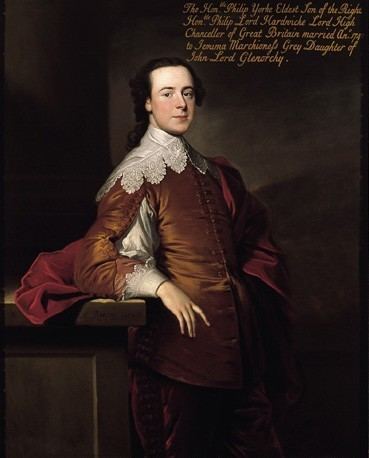Name Philip 2nd Role Politician | Died May 16, 1790 | |
 | ||
Spouse Jemima Yorke, 2nd Marchioness Grey (m. 1740–1790) Children Annabella Yorke, Countess de Grey of Wrest, Mary Robinson, Baroness Grantham Parents Philip Yorke, 1st Earl of Hardwicke, Margaret Cocks Siblings Joseph Yorke, 1st Baron Dover, James Yorke, Hon. John Yorke, Lady Elizabeth Yorke, Lady Margaret Yorke Grandchildren F. J. Robinson, 1st Viscount Goderich, Thomas de Grey, 2nd Earl de Grey | ||
Philip Yorke, 2nd Earl of Hardwicke | Wikipedia audio article
Philip Yorke, 2nd Earl of Hardwicke FRS (9 March 1720 – 16 May 1790) was an English politician.
Contents
Life
The eldest son of Philip Yorke, 1st Earl of Hardwicke, he was educated at Corpus Christi College, Cambridge. In 1741 he became a Fellow of the Royal Society.
He sat in the House of Commons as member for Reigate (1741–47), and afterwards for Cambridgeshire; and he kept notes of the debates which were afterwards embodied in Cobbett's Parliamentary History. During the political crisis over the loss of Minorca to the French in 1756, Lord Royston was tapped with collecting favourable press accounts of the ministry. He joined his father, as well as Lord Mansfield, to defend the Newcastle ministry during the parliamentary inquiries following the execution of Admiral John Byng.
He was styled Viscount Royston from 1754 till 1764, when he succeeded to the earldom. In politics he supported the Rockingham Whigs. He held the office of Teller of the Exchequer, and was Lord Lieutenant of Cambridgeshire and high steward of Cambridge University. He edited a quantity of miscellaneous state papers and correspondence, to be found in manuscript collections in the British Museum. Between 1756 and 1760, he served in the honorary position of vice president of the Foundling Hospital, a charitable institution providing for London's abandoned children.
He is buried in Flitton, Bedfordshire with a monument by Thomas Banks.
Works
With his brother, Charles Yorke, he was one of the chief contributors to Athenian Letters; or the Epistolary Correspondence of an agent of the King of Persia residing at Athens during the Peloponnesian War (4 vols., London, 1741), a work that for many years had a considerable vogue and went through several editions.
Family
On 22 May 1740, he married Lady Jemima Campbell, only daughter of John Campbell, 3rd Earl of Breadalbane, and granddaughter and heiress of Henry Grey, 1st Duke of Kent, who became in her own right Marchioness Grey. They had two daughters:
He was succeeded in the earldom by his nephew Philip.
